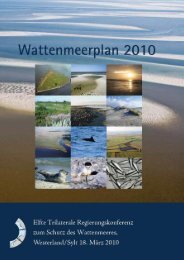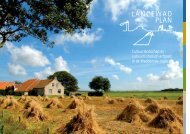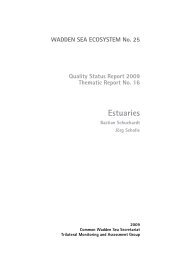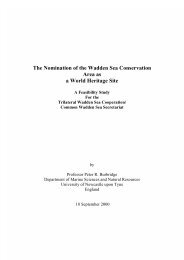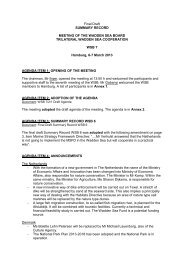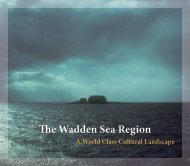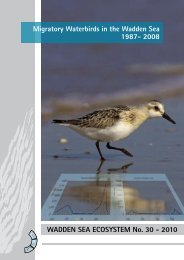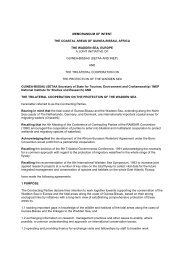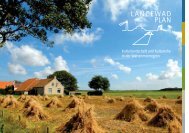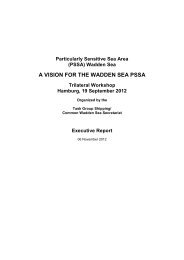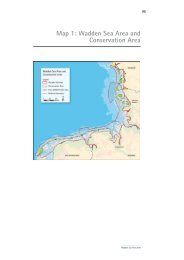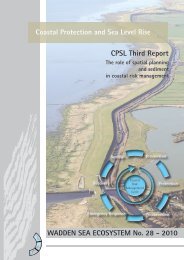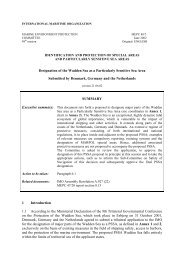The Wadden Sea 20 0 - Trilateral Wadden Sea Cooperation-CWSS ...
The Wadden Sea 20 0 - Trilateral Wadden Sea Cooperation-CWSS ...
The Wadden Sea 20 0 - Trilateral Wadden Sea Cooperation-CWSS ...
You also want an ePaper? Increase the reach of your titles
YUMPU automatically turns print PDFs into web optimized ePapers that Google loves.
<strong>The</strong> <strong>Wadden</strong> <strong>Sea</strong> <strong>20</strong> 0<br />
<strong>The</strong> <strong>Wadden</strong> <strong>Sea</strong> – A Universally<br />
Outstanding Tidal Wetland<br />
<strong>The</strong> <strong>Wadden</strong> <strong>Sea</strong> Quality Status Report<br />
- Synthesis Report <strong>20</strong> 0<br />
A universally outstanding tidal wetland<br />
<strong>Wadden</strong> <strong>Sea</strong> Ecosystem No. 29 � <strong>20</strong>10
2<br />
A universally outstanding tidal wetland<br />
<strong>Wadden</strong> <strong>Sea</strong> Ecosystem No. 29 � <strong>20</strong>10<br />
Colophon<br />
Publisher<br />
Common <strong>Wadden</strong> <strong>Sea</strong> Secretariat (<strong>CWSS</strong>), Wilhelmshaven, Germany;<br />
Language support<br />
<strong>Sea</strong>bury Salmon<br />
Cover Photo<br />
Klaus Janke<br />
Lay�out and technical editing<br />
Common <strong>Wadden</strong> <strong>Sea</strong> Secretariat<br />
Graphic support<br />
Gerold Lüerßen<br />
Published<br />
<strong>20</strong>10<br />
ISSN 0946�896X<br />
This publication should be cited as:<br />
Karsten Reise, Martin Baptist, Peter Burbridge, Norbert Dankers, Ludwig Fischer, Burghard Flemming,<br />
Albert P. Oost, Cor Smit, <strong>20</strong>10. <strong>The</strong> <strong>Wadden</strong> <strong>Sea</strong> – A Universally Outstanding Tidal Wetland. <strong>Wadden</strong> <strong>Sea</strong><br />
Ecosystem No. 29. Common <strong>Wadden</strong> <strong>Sea</strong> Secretariat, Wilhelmshaven, Germany, page 7 � 24.<br />
Wim J. Wolff, Jan P. Bakker, Karsten Laursen, Karsten Reise, <strong>20</strong>10. <strong>The</strong> <strong>Wadden</strong> <strong>Sea</strong> Quality Status Report<br />
� Synthesis Report <strong>20</strong>10. <strong>Wadden</strong> <strong>Sea</strong> Ecosystem No. 29. Common <strong>Wadden</strong> <strong>Sea</strong> Secretariat, Wilhelms�<br />
haven, Germany, page 25 � 74.
<strong>The</strong> designation of the Dutch and German parts<br />
of the <strong>Wadden</strong> <strong>Sea</strong> Conservation Area as a World<br />
Heritage Site by UNESCO in June <strong>20</strong>09 was a major<br />
step in formally recognizing the global importance<br />
of the <strong>Wadden</strong> <strong>Sea</strong> as a nature area. As such, it<br />
is managed through a joint effort of Denmark,<br />
Germany and <strong>The</strong> Netherlands. <strong>The</strong>refore, the QSR<br />
Synthesis Report <strong>20</strong>10 is preceded by a summary<br />
report of the universally outstanding and most<br />
significant natural values. This is based on the<br />
nomination dossier and is here extended to cover<br />
the entire <strong>Wadden</strong> <strong>Sea</strong><br />
In this <strong>Trilateral</strong> <strong>Wadden</strong> <strong>Sea</strong> <strong>Cooperation</strong>, the<br />
<strong>Trilateral</strong> Monitoring and Assessment Program<br />
(TMAP) plays a central role, providing the basis<br />
for a periodic assessment of the condition of the<br />
<strong>Wadden</strong> <strong>Sea</strong> ecosystem, and for an evaluation of<br />
progress towards the ecological targets set out in<br />
the <strong>Wadden</strong> <strong>Sea</strong> Plan.<br />
This Quality Status Report <strong>20</strong>09 (QSR <strong>20</strong>09)<br />
was prepared to update the findings of the QSR<br />
<strong>20</strong>04 and to provide input into the <strong>Trilateral</strong><br />
Governmental Conference on Sylt on 18 March<br />
<strong>20</strong>10. <strong>The</strong> work was coordinated by the Common<br />
<strong>Wadden</strong> <strong>Sea</strong> Secretariat and the <strong>Trilateral</strong> Moni�<br />
toring and Assessment Group. Over 115 scientists<br />
from <strong>The</strong> Netherlands, Germany and Denmark<br />
contributed to this project during <strong>20</strong>08�<strong>20</strong>09.<br />
<strong>The</strong>y prepared 30 thematic reports which were<br />
published in November <strong>20</strong>09 (http://www.wad�<br />
densea�secretariat.org/QSR�<strong>20</strong>09/index.htm).<br />
<strong>The</strong>se thematic reports, together with findings<br />
from the 12 th International <strong>Wadden</strong> <strong>Sea</strong> Sympo�<br />
sium (Wilhelmshaven, 30 March – 3 April <strong>20</strong>09)<br />
(<strong>Wadden</strong> <strong>Sea</strong> Ecosystem No. 26) provide the basis<br />
for the QSR synthesis report presented here. It<br />
summarizes the main findings of the QSR thematic<br />
reports and attempts to present an integrated<br />
assessment of the main ecosystem developments<br />
and identify main issues of concern and gaps of<br />
knowledge for science, management and policy.<br />
Common <strong>Wadden</strong> <strong>Sea</strong> Secretariat<br />
A universally outstanding tidal wetland<br />
Foreword<br />
<strong>Wadden</strong> <strong>Sea</strong> Ecosystem No. 29 � <strong>20</strong>10
A universally outstanding tidal wetland<br />
<strong>Wadden</strong> <strong>Sea</strong> Ecosystem No. 29 � <strong>20</strong>10
<strong>The</strong> <strong>Wadden</strong> <strong>Sea</strong> <strong>20</strong> 0<br />
<strong>The</strong> <strong>Wadden</strong> <strong>Sea</strong> – A Universally<br />
Outstanding Tidal Wetland<br />
Karsten Reise, Martin Baptist, Peter Burbridge, Norbert Dankers, Ludwig<br />
Fischer, Burghard Flemming, Albert P. Oost, Cor Smit ______ page 7<br />
<strong>The</strong> <strong>Wadden</strong> <strong>Sea</strong> Quality Status Report<br />
- Synthesis Report <strong>20</strong> 0<br />
Wim J. Wolff, Jan P. Bakker, Karsten Laursen, Karsten Reise page 2<br />
A universally outstanding tidal wetland<br />
<strong>Wadden</strong> <strong>Sea</strong> Ecosystem No. 29 � <strong>20</strong>10
A universally outstanding tidal wetland<br />
<strong>Wadden</strong> <strong>Sea</strong> Ecosystem No. 29 � <strong>20</strong>10
WADDEN SEA ECOSYSTEM No. 29<br />
<strong>The</strong> <strong>Wadden</strong> <strong>Sea</strong> – A Universally<br />
Outstanding Tidal Wetland<br />
A universally outstanding tidal wetland<br />
Karsten Reise<br />
Martin Baptist<br />
Peter Burbridge<br />
Norbert Dankers<br />
Ludwig Fischer<br />
Burghard Flemming<br />
Albert P. Oost<br />
Cor Smit<br />
<strong>20</strong> 0<br />
Common <strong>Wadden</strong> <strong>Sea</strong> Secretariat<br />
7<br />
<strong>Wadden</strong> <strong>Sea</strong> Ecosystem No. 29 � <strong>20</strong>10
A universally outstanding tidal wetland<br />
<strong>Wadden</strong> <strong>Sea</strong> Ecosystem No. 29 � <strong>20</strong>10<br />
This publication should be cited as:<br />
Karsten Reise, Martin Baptist, Peter Burbridge, Norbert Dankers, Ludwig Fischer, Burghard Flemming,<br />
Albert P. Oost, Cor Smit, <strong>20</strong>10. <strong>The</strong> <strong>Wadden</strong> <strong>Sea</strong> – A Universally Outstanding Tidal Wetland. <strong>Wadden</strong> <strong>Sea</strong><br />
Ecosystem No. 29. Common <strong>Wadden</strong> <strong>Sea</strong> Secretariat, Wilhelmshaven, Germany, page 7 � 24.
Along the North <strong>Sea</strong> shore, the largest coherent<br />
tidal flat area of the temperate world has evolved.<br />
Sediment supply from the sea has sufficiently<br />
balanced a slow sea�level rise in the last 8,000<br />
years to maintain a coastal configuration of a<br />
seaward sandy barrier, extensive tidal flats and<br />
episodically flooded marshes. <strong>The</strong> <strong>Wadden</strong> <strong>Sea</strong> is<br />
unique in that it consists of vast (4,700 km²) bare<br />
sand and mud flats, emerging twice daily at low<br />
tide. Oceanic waters dominate river influence, and<br />
dynamic sandy shoals and dune islands provide a<br />
partial shelter against waves and winds of a rough<br />
sea. In the course of a year, the <strong>Wadden</strong> <strong>Sea</strong> is<br />
visited by an unparalleled 10�12 million birds for<br />
foraging and resting on their East Atlantic flyway.<br />
Food provision in the form of tidal flat fauna<br />
is 10�<strong>20</strong> times higher than in adjacent deeper<br />
waters. When the tide is in, the flats serve as a<br />
rich nursery for shrimp and fish. <strong>The</strong> <strong>Wadden</strong> <strong>Sea</strong><br />
constitutes a gigantic biological filter between<br />
land and sea. This filter is primarily composed (1)<br />
of extensive beds of molluscan suspension feeders<br />
which filter the local tidal volume about twice a<br />
month, (2) of sediment kept permeable by bio�<br />
turbating lugworms, and (3) of marsh vegetation<br />
which functions as a filter during episodic storm<br />
surges when waters are loaded with re�suspended<br />
fine particles. An impressive number of about<br />
10,000 species of plants, fungi and animals thrive<br />
in the <strong>Wadden</strong> <strong>Sea</strong>. After a long phase of over�<br />
exploitation, protection measures have triggered<br />
spectacular recoveries in breeding birds and seals.<br />
Large�scale land claims have ceased and the Wad�<br />
den <strong>Sea</strong> is today highly rated for its serene beauty.<br />
Global warming with an accelerating sea�level<br />
rise, however, may threaten the sandy barrier and<br />
the extent of the tidal flats.<br />
A universally outstanding tidal wetland<br />
Abstract<br />
9<br />
Bird flock on the <strong>Wadden</strong><br />
<strong>Sea</strong> beach (Photo: J. van<br />
de Kam).<br />
<strong>Wadden</strong> <strong>Sea</strong> Ecosystem No. 29 � <strong>20</strong>10
0 A universally outstanding tidal wetland<br />
. Introduction<br />
Figure 1:<br />
Satellite images taken in<br />
<strong>20</strong>00-<strong>20</strong>02 and combined<br />
to show low tide<br />
conditions everywhere. In<br />
reality tidal waves progress<br />
counter-clockwise over a<br />
six-hour period through<br />
the <strong>Wadden</strong> <strong>Sea</strong> (Source:<br />
Eurimage, Common<br />
<strong>Wadden</strong> <strong>Sea</strong> Secretariat<br />
& Brockmann Consult).<br />
Arrows indicate boundaries<br />
between sub-regions.<br />
Inset shows tidal basins<br />
in the Northern <strong>Wadden</strong><br />
<strong>Sea</strong> (modified from CPSL,<br />
<strong>20</strong>05).<br />
<strong>Wadden</strong> <strong>Sea</strong> Ecosystem No. 29 � <strong>20</strong>10<br />
<strong>The</strong> earliest and most famous historical testimony<br />
of the <strong>Wadden</strong> <strong>Sea</strong> is recorded in the ‘Historia<br />
Naturalis’ by Plinius the Elder who visited the<br />
southern coast of the North <strong>Sea</strong> in the year 47<br />
AD. He was amazed by the ‘indistinctness’ and<br />
‘immeasurable expanse’ of land inundated by the<br />
sea twice daily. <strong>The</strong> intimate bond between the<br />
people and this changeable environment was quite<br />
incomprehensible to him. However, perception<br />
of pleasure was derived from the <strong>Wadden</strong> <strong>Sea</strong><br />
when in the 18�19th centuries the ‘aesthetics of<br />
the sublime’ stimulated human senses to ascribe<br />
outstanding value to this serene coastal sea with<br />
land diving under water and water running off<br />
the land, with an open horizon and limitless sky,<br />
and a calm sea which may all of a sudden turn<br />
wild with an arising torrential storm (Fischer and<br />
Hasse, <strong>20</strong>01).<br />
<strong>The</strong> <strong>Wadden</strong> <strong>Sea</strong> is mostly shallow enough to<br />
wade across. <strong>The</strong> unique vastness of the tidal flats<br />
and shoals, fringing salt marshes, wide beaches<br />
and dune islands with a spectacular abundance of<br />
wildlife has been the motivation for proposing the<br />
<strong>Wadden</strong> <strong>Sea</strong> as a UNESCO World Heritage Site. <strong>The</strong><br />
following text is condensed from the description<br />
and justification chapters of the Dutch�German<br />
nomination dossier (<strong>CWSS</strong>, <strong>20</strong>08, <strong>20</strong>09), but here<br />
extended to cover the entire <strong>Wadden</strong> <strong>Sea</strong> area<br />
including the Danish part. <strong>The</strong> foremost question<br />
was: On which universally outstanding, most<br />
significant natural values should the inscription<br />
be based? We have employed major reviews of<br />
scientific knowledge (Wolff 1983), quality assess�<br />
ments (<strong>CWSS</strong>, 1991; De Jong, 1999; Essink et al.,<br />
<strong>20</strong>05; Marencic & de Vlas, <strong>20</strong>09), and cite repre�<br />
sentative studies on the geomorphology, ecology<br />
and biology of the region from the 19th century<br />
onwards. Comparisons with other coasts of the<br />
world are based on Reineck and Singh (1980),<br />
Flemming (<strong>20</strong>02), Reise (<strong>20</strong>01) and own surveys<br />
(see annex 3 in <strong>CWSS</strong>, <strong>20</strong>08). <strong>The</strong> purpose of this<br />
paper is to provide a concise overview on physical<br />
and biotic values which lend the <strong>Wadden</strong> <strong>Sea</strong> a<br />
universally outstanding status worthy for inscrip�<br />
tion as UNESCO World Heritage Site.
<strong>The</strong> <strong>Wadden</strong> <strong>Sea</strong> has the world’s largest continu�<br />
ous belt of bare tidal flats partially sheltered by<br />
a sandy barrier against a rough sea, with the<br />
latter’s waters dominating river influence. When<br />
post�glacial sea level rise began to slow down<br />
about 8,000 years ago, the <strong>Wadden</strong> <strong>Sea</strong> emerged<br />
with a seaward barrier of dune islands and sandy<br />
shoals, and a landward area of tidal flats and salt<br />
marshes (Zagwijn, 1986; Flemming and Davis,<br />
1994). <strong>The</strong> rates of sea�level rise and sediment<br />
supply varied over time and locality, causing<br />
continuous dynamics in the coastal morphology of<br />
the <strong>Wadden</strong> <strong>Sea</strong>. As a result, at times parts of the<br />
coast have grown where the sea tides and waves<br />
have washed in more sediment from the adjacent<br />
offshore zone than was needed to compensate for<br />
sea level rise. At other times, the coast retreated<br />
in some places when sediment supply has been<br />
unable to compensate for sea level rise. In this<br />
way, the Holocene history of sea level, climate,<br />
and depositional responses has been preserved in<br />
the stratigraphic record of the <strong>Wadden</strong> <strong>Sea</strong> (Streif,<br />
1989; Bartholdy and Pejrup, 1994; Behre, <strong>20</strong>03).<br />
With the <strong>Wadden</strong> <strong>Sea</strong>, a universally outstand�<br />
ing coastal landscape has arisen at the southern<br />
and eastern shores of the North <strong>Sea</strong> (Figure 1).<br />
Along a coastal stretch of approximately 500 km,<br />
an uninterrupted belt of sand and mud flats with<br />
a total area of 4,700 km² is exposed to the air and<br />
then covered by water twice daily in the rhythm<br />
of the tides. This belt of tidal flats is dissected by<br />
more than 30 branching tidal inlets and five major<br />
estuaries. Such a vast and coherent intertidal area<br />
not covered by salt marsh vegetation is found<br />
nowhere else in the world.<br />
<strong>The</strong>re are many other sedimentary coasts<br />
which, in one way or another, resemble the Wad�<br />
den <strong>Sea</strong> morphologically but are much smaller or<br />
differ in terms of climate, river influence, tides<br />
or waves. Other large tidal flats can be found in<br />
the Arctic, but there the tides tend to be smaller<br />
than in the <strong>Wadden</strong> <strong>Sea</strong>, and the shore is frozen<br />
and covered by ice most of the year. In tropical<br />
and subtropical climates, the tidal zone is often<br />
occupied by mangroves, whereas in the <strong>Wadden</strong><br />
<strong>Sea</strong> tidal flats lack upright growing plants, except<br />
for salt marsh vegetation above mean high�tide<br />
level. On other coasts, most of the sediment is<br />
directly supplied from the hinterland by rivers,<br />
and salinity is ususally low or variable. Examples<br />
of such coasts are the Arctic Lena Delta, the tem�<br />
perate Mississippi Delta or tropical deltaic regions<br />
of the Amazon, Niger or Ganges. Also, the wide<br />
mud flats along the coasts of the Yellow <strong>Sea</strong> have<br />
been built up by rivers.<br />
<strong>The</strong> <strong>Wadden</strong> <strong>Sea</strong> is special in that almost all of<br />
the sediments are supplied from the adjacent sea<br />
with only a minor or local river influence (Arends,<br />
1833; van Straaten and Kuenen, 1957). Salinity<br />
ranges mostly between <strong>20</strong> and 30 psu, which is<br />
less than in the open ocean (34) but more than<br />
in estuaries (0�<strong>20</strong>), where most other intertidal<br />
flats are found in Europe. Large sand and mud<br />
flats occur along the NW African coast where<br />
the Banc d’Arguin covers an area of 630 km² and<br />
which corresponds to 13% of the tidal flat area<br />
of the <strong>Wadden</strong> <strong>Sea</strong> (Wolff et al., 1993). <strong>The</strong>se tidal<br />
flats constitute a relic from a former river delta,<br />
and are intimately linked to the <strong>Wadden</strong> <strong>Sea</strong> by<br />
its wading birds overwintering there (Wymenga<br />
et al., 1990). <strong>The</strong> <strong>Wadden</strong> <strong>Sea</strong> comprises about<br />
60% of the intertidal area at the north�eastern<br />
Atlantic shores.<br />
A further feature of the <strong>Wadden</strong> <strong>Sea</strong> is a sea�<br />
ward barrier of sandy islands and shoals which is<br />
a consequence of moderate tidal ranges, and sand<br />
having been supplied from the offshore by waves<br />
and subsequently moved by the wind (Oost and<br />
de Boer, 1994). Tides have increased with the ris�<br />
ing level of the sea and today span from 1.5 to 4<br />
m. Below a tidal range of about 0.5 m, unbroken<br />
barrier spits and lagoons develop and above about<br />
3.5 m barrier islands no longer occur due to the<br />
large tidal prisms. <strong>The</strong> <strong>Wadden</strong> <strong>Sea</strong> may be divided<br />
into three morphological sub�regions (see arrows<br />
in Figure 1), based on tidal ranges between 1.5<br />
to 3 m in the South and North, and >3 m in the<br />
central part, as well as on coastal orientation and<br />
river influence:<br />
• In the Southern <strong>Wadden</strong> <strong>Sea</strong>, twelve major<br />
barrier islands located 5 to 15 km off the<br />
mainland shore, shelter the tidal area against<br />
waves generated by northwesterly and north�<br />
erly winds. Sediment imported from the sea<br />
does not fully compensate for sea�level rise<br />
and islands migrate landwards. A large embay�<br />
ment, the former brackish Zuiderzee (3,600<br />
km²), was part of the Southern <strong>Wadden</strong> <strong>Sea</strong><br />
until it was separated by a dam in 1932. It<br />
was subsequently converted into a freshwater<br />
lake and arable land. Another embayment, the<br />
estuarine Dollard, still exists.<br />
• In the Central <strong>Wadden</strong> <strong>Sea</strong>, tidal ranges often<br />
exceed 3 m and there are four estuaries caus�<br />
ing a lower and more variable salinity than<br />
in the other two regions. A seaward chain<br />
of barrier islands is absent. Here, sediment<br />
import seems to balance sea�level rise. With<br />
the Jadebusen, a large embayment extends<br />
deep into the low�lying coastal marshland.<br />
A universally outstanding tidal wetland<br />
2. Physical Environment<br />
<strong>Wadden</strong> <strong>Sea</strong> Ecosystem No. 29 � <strong>20</strong>10
2 A universally outstanding tidal wetland<br />
Figure 2:<br />
Tidal divide where tidal<br />
creeks running northward<br />
intersect a coherent<br />
seagrass bed (dark colour),<br />
while creeks running southwest<br />
(upper right) intersect<br />
a sandy flat with scattered<br />
seagrass patches (Photo: K.<br />
Reise).<br />
<strong>Wadden</strong> <strong>Sea</strong> Ecosystem No. 29 � <strong>20</strong>10<br />
• In the Northern <strong>Wadden</strong> <strong>Sea</strong>, eight islands and<br />
elevated sand bars form a seaward barrier 5 to<br />
25 km off the mainland. <strong>The</strong>y provide shelter<br />
against waves generated by the prevailing<br />
westerly winds. Mostly, sediment supply does<br />
not compensate for sea�level rise, except for<br />
an oversupply between the islands of Rømø<br />
and Fanø. Several marsh islands are scattered<br />
across the tidal area. <strong>The</strong>se are remnants of a<br />
coherent marshland which became drowned<br />
in late medieval times. In the North, some<br />
Pleistocene cliffs meet the sea.<br />
A distinctive hydrological feature of the <strong>Wadden</strong><br />
<strong>Sea</strong> is a series of tidal basins which are marine<br />
analogues to river catchments (Postma, 1954;<br />
Ehlers, 1988). However, flow direction alternates<br />
with the tides (see inset in Figure 1). <strong>The</strong> exist�<br />
ence of tidal basins is interrelated with barrier<br />
islands and elevated sands. Between these, the<br />
tidal flow is compressed and scours deep tidal<br />
inlets with a mean flow of about 1 m s�1 . Be�<br />
hind the barrier islands, most inlets branch into<br />
major tidal channels which, in turn, branch into<br />
successively smaller tidal creeks or runnels in<br />
a recurrent fractal pattern. In the back�barrier<br />
area, flood waters of adjacent tidal inlets meet<br />
at tidal divides (watersheds) where currents tend<br />
to calm down (Figure 2). Other than in lagoons,<br />
tidal divides allow for a direct lateral connection<br />
between basins. <strong>Sea</strong>ward of tidal inlets, ebb�delta<br />
shoals are formed. Here, ebb currents interact with<br />
waves and a long�shore current which runs from<br />
southwest towards northeast.<br />
<strong>The</strong> sediment distribution along deltaic coasts<br />
is typically from coarse materials inshore to pro�<br />
gressively finer sediments offshore. In the <strong>Wadden</strong><br />
<strong>Sea</strong>, by contrast, the decrease in grain size is the<br />
other way round (van Straaten, 1954). This differ�<br />
ence is caused by the sediment transport routes<br />
perpendicular to the shore running in opposite<br />
directions, whith the source either rivers or the<br />
sea. Along tropical and subtropical coasts, tidal<br />
flats may also develop behind a barrier of coralline<br />
reefs. Here the sediment particles primarily consist<br />
of biogenic carbonates, whereas in the <strong>Wadden</strong><br />
<strong>Sea</strong> siliclastic sediments prevail.<br />
Strong hydraulic and aeolian dynamics are<br />
an important characteristic of the <strong>Wadden</strong> <strong>Sea</strong><br />
region. Twice a day the tides move an average<br />
volume of 15 km³ of sea water through the tidal<br />
channels and inlets into the tidal basins where<br />
roughly the same volume remains at low tide, thus<br />
swelling up to some 30 km³ at high tide. A high<br />
exchange rate of tidal water masses secures the<br />
dominance of marine conditions in the back�bar�<br />
rier area (Postma, 1954). In the course of a tidal<br />
cycle, the sum of freshwater discharge is
Ecologically the <strong>Wadden</strong> <strong>Sea</strong> functions as a gi�<br />
gantic coastal filter of unique composition, and<br />
offers plenty of food to a rich aquatic nursery and<br />
to 10�12 million birds in the course of a year. <strong>The</strong><br />
habitats of the <strong>Wadden</strong> <strong>Sea</strong> show in a fascinating<br />
way how physical forces and biological activities<br />
interact to generate conditions for life in a frag�<br />
ile balance. Along this coast physical forces are<br />
strong, biological activities high, and the basic<br />
materials are soft sediments and fluid waters.<br />
This combination makes the dynamic interactions<br />
between organisms and their environment readily<br />
apparent and attractive to study. Major habitats<br />
are arranged along an offshore�inshore gradient<br />
and from deep tidal inlets up to the highest dunes:<br />
an offshore belt seaward of the barrier islands, a<br />
tidal area with subtidal gullies and shoals, inter�<br />
tidal mud and sand, with seagrass meadows or<br />
mixed oyster and mussel beds, a few estuaries,<br />
salt marshes on islands and along the mainland<br />
coast, beaches and dunes mainly on the islands.<br />
<strong>The</strong>se habitats are functionally interrelated and<br />
constitute a characteristic combination.<br />
<strong>The</strong> offshore belt of the <strong>Wadden</strong> <strong>Sea</strong> is opera�<br />
tionally defined as the zone seaward of the barrier<br />
islands and elevated outer sands, extending into<br />
the North <strong>Sea</strong> down to the –15 m depth contour.<br />
This belt has no tidal flats and drops off smoothly<br />
towards the open North <strong>Sea</strong> but does not fully<br />
comply with it in terms of the biota. <strong>The</strong>re is a<br />
continuous exchange of both water and sediment<br />
with the tidal area. <strong>The</strong> sediment supply from the<br />
offshore belt is vital for the resilience of the coast<br />
when responding to changes in tidal area, sea<br />
level and to disturbances caused by storm surges<br />
(Flemming and Bartholomä, 1997). Phytoplankton<br />
blooms often start in this belt because turbidity is<br />
low enough for sufficient light and nutrient con�<br />
centrations are high (Postma, 1954; van Beusekom<br />
and de Jonge, <strong>20</strong>02). Through the tidal channels<br />
and inlets this offshore primary production reaches<br />
the inshore zoobenthos. In the offshore belt,<br />
autotrophic production prevails and in the tidal<br />
area, heterotrophic production is dominant. Also<br />
larvae of benthic fauna and fish drift from the<br />
offshore belt further inshore. Shrimp, fish, diving<br />
birds, seals and harbour porpoises readily commute<br />
between offshore and inshore zones (Bückmann,<br />
1934; Wolff and Zijlstra, 1980). In severe winters,<br />
the offshore belt provides an important refuge for<br />
the survival of populations otherwise confined to<br />
the tidal area.<br />
Within the tidal area, the subtidal shoals and<br />
gullies similarly serve as a refuge for the intertidal<br />
fauna when conditions turn harsh. <strong>The</strong> subtidal<br />
fringe and low intertidal zone are the primary<br />
sites for beds of suspension feeders, mussels and<br />
oysters in particular (Hagmeier and Kändler, 1927).<br />
Mussels are kept in bottom cultures and also oc�<br />
cur naturally in mixed beds with oysters (Figure 3;<br />
Dankers and Zuidema, 1995; Nehls et al., <strong>20</strong>06). A<br />
native subtidal oyster has been driven to extinction<br />
by over�exploitation, while the introduced Pacific<br />
oyster recently invaded the intertidal mussel beds.<br />
A universally outstanding tidal wetland<br />
. Ecology<br />
Figure 3:<br />
Bed of suspension feeding<br />
mussels (Mytilus edulis)<br />
bound together by byssal<br />
threads. Shells are partly<br />
overgrown by barnacles<br />
(mainly Elminius modestus),<br />
a few oysters (Crassostrea<br />
gigas), bladder wrack (Fucus<br />
vesiculosus forma mytili),<br />
and periwinkles (Littorina<br />
littorea) graze on microbial<br />
films (Photo: K. Reise).<br />
<strong>Wadden</strong> <strong>Sea</strong> Ecosystem No. 29 � <strong>20</strong>10
A universally outstanding tidal wetland<br />
Figure 4:<br />
Fecal castings of lugworms<br />
(Arenicola marina) which<br />
are reworking and irrigating<br />
vast tidal flats in the <strong>Wadden</strong><br />
<strong>Sea</strong>, thereby maintaining<br />
a permeable sandy<br />
sediment (Photo: K. Reise).<br />
<strong>Wadden</strong> <strong>Sea</strong> Ecosystem No. 29 � <strong>20</strong>10<br />
Together with other suspension feeders, the entire<br />
volume of tidal waters is filtered within two weeks<br />
(Verwey, 1952). Mussels and oysters also stabilize<br />
the bottom and accrete fine sediments, accumu�<br />
late large amounts of shell material, provide at�<br />
tachment for algae and sessile invertebrates, and<br />
shelter for mobile invertebrates and fish. This rich<br />
association served as a model for the community<br />
concept (biocoenosis) developed by Möbius (1877)<br />
with the assumption of balanced species interac�<br />
tions maintaining a community of organisms. This<br />
concept is still favoured in ecological textbooks.<br />
Tidal elevation and sediment composition are<br />
two major determinants of benthic assemblages<br />
on the tidal flats (Thamdrup, 1935; Wohlenberg,<br />
1937; Linke, 1939). Suspended fine particles,<br />
mostly comprising aggregates of mineral grains<br />
and organics, tend to accumulate on the landward<br />
side of the tidal flats (Postma, 1961; Dronkers,<br />
1984). This general phenomenon was initially<br />
explained by van Straaten and Kuenen (1957)<br />
with a combination of settling lag and scour lag.<br />
<strong>The</strong> former is a time lag between the moment at<br />
which a decreasing current is no longer able to<br />
hold a particle in suspension and the moment at<br />
which this particle reaches the bottom. <strong>The</strong> lat�<br />
ter is the time lag caused, among others, by the<br />
extracellular slime of the microalgal film on the<br />
bottom, binding settling particles so that stronger<br />
currents are required for re�suspension than the<br />
velocity at which deposition of the same particle<br />
had occurred. <strong>The</strong> vast tidal flats of the <strong>Wadden</strong><br />
<strong>Sea</strong> serve as a primary example for this progres�<br />
sively shoreward�fining gradient in particle size.<br />
<strong>The</strong> sediment surface is almost completely cov�<br />
ered with microscopic algae and bacterial colonies.<br />
Some of these are mobile and once buried under<br />
new deposits, they crawl back to the surface. This<br />
behavior may generate a laminated structure of<br />
mud deposition until reworked by the occasional<br />
storm surges (Wohlenberg, 1953). Intertidal sea�<br />
grass beds may also accumulate fine particles.<br />
However, most leaves are shed in autumn and then<br />
waves re�suspend the intermittent accretion. <strong>The</strong><br />
most extensive seagrass meadows occur in the<br />
Northern <strong>Wadden</strong> <strong>Sea</strong> on approximately 10% of<br />
the tidal flat area, and these represent the largest<br />
intertidal seagrass beds in Europe (Figure 2; Reise<br />
and Kohlus, <strong>20</strong>08).<br />
A large proportion of the tidal flats of the<br />
<strong>Wadden</strong> <strong>Sea</strong> consist of wave�rippled sands. This<br />
habitat is maintained by the constant sediment<br />
reworking of lugworms (Figure 4). In analogy to<br />
Darwin who described the role of earthworms in<br />
the shaping of the landscape in England, lugworms<br />
shape the appearance of the tidal flats and the<br />
spatial relationship between mud and sand flats<br />
in the <strong>Wadden</strong> <strong>Sea</strong>. <strong>The</strong>ir fecal mounds with<br />
coiled strings of sand are the most characteristic<br />
feature of the tidal flats in the <strong>Wadden</strong> <strong>Sea</strong>. <strong>The</strong><br />
total population size may comprise about one<br />
billion worms and this is considered the largest
worldwide. Lugworms recycle the upper layer<br />
of the sediment 10�<strong>20</strong> times per year through<br />
their guts (Cadée, 1976) and prevent clogging<br />
of the interstices of sand with organic material<br />
(Volkenborn et al., <strong>20</strong>07). <strong>The</strong>y also irrigate their<br />
burrows with water from above and build up an<br />
oxic environment in otherwise anoxic sediment.<br />
This increases bacterial activity and the perme�<br />
able sand functions as an effective filter for the<br />
tidal waters.<br />
<strong>The</strong> impressive ecological productivity of the<br />
tidal flats comprises high bacterial remineralisa�<br />
tion rates, strong import of suspended microalgae,<br />
and a generally high productivity at the bottom by<br />
microscopic algae instead of large plants (Cadée<br />
and Hegeman, 1974; Loebl et al., <strong>20</strong>07). Together<br />
this constitutes a readily consumable food supply<br />
for a zoobenthos which builds up an exceptionally<br />
high biomass, dominated by molluscan suspen�<br />
sion feeders, followed by deposit feeding worms<br />
and small snails (Beukema, 1976; Beukema et al,.<br />
<strong>20</strong>02; Asmus, 1987; Reise et al., 1994). <strong>The</strong>se in<br />
turn provide plenty of food for small crabs, shrimp<br />
and fish which use the flats as a nursery when the<br />
tide is in (Smidt, 1951; Kuipers, 1977; Strasser,<br />
<strong>20</strong>02), and for huge flocks of wading birds, gulls<br />
and ducks when the tide is out (Piersma, 1987;<br />
Scheiffarth and Nehls, 1997). <strong>The</strong>se have the<br />
advantage of searching for prey on a very large<br />
intertidal area, with a fair chance of frequently<br />
encountering patches of a sufficient quality and<br />
quantity of accessible food. On the permanently<br />
submerged bottom of the North <strong>Sea</strong>, the zoomass<br />
is 10�<strong>20</strong> times lower than on the tidal flats. This<br />
is why the <strong>Wadden</strong> <strong>Sea</strong> can feed 10�12 million<br />
coastal birds in the course of a year (Blew et al.,<br />
<strong>20</strong>05). Most of these are migrants along the East<br />
Atlantic flyway and use the <strong>Wadden</strong> <strong>Sea</strong> as their<br />
central staging area to replenish energy lost dur�<br />
ing breeding and long�distance flights (Figure 5).<br />
Thus, the <strong>Wadden</strong> <strong>Sea</strong> feeds birds which travel to<br />
many other coasts or fly further inland. Similarly,<br />
the tidal flat fauna offers food for young fish<br />
which as adults migrate into the open sea or into<br />
the rivers. <strong>Sea</strong>ls and harbour porpoises are at the<br />
top of the aquatic food web, and birds of prey<br />
represent a link to the terrestrial food web (Baird<br />
et al., <strong>20</strong>04). A diverse assemblage of parasites<br />
hitchhikes on these trophic pathways (Thieltges<br />
et al., <strong>20</strong>06).<br />
<strong>The</strong> estuaries as tidally influenced transition<br />
zones between marine and riverine environments<br />
are not a dominant feature and are small in size<br />
relative to the marine parts of the <strong>Wadden</strong> <strong>Sea</strong><br />
(Harten and Vollmers, 1978). This is in contrast to<br />
most other tidal areas in Europe and the world.<br />
Nevertheless, these estuaries supply the <strong>Wadden</strong><br />
<strong>Sea</strong> with nutrients, are pathways for diadromous<br />
fish and add habitats of low and variable salin�<br />
ity.<br />
Mangroves and salt marshes dominate tidal<br />
areas along most tropical and temperate sedimen�<br />
tary coasts of the world. However, in the <strong>Wadden</strong><br />
<strong>Sea</strong>, climate is too cold for mangroves and salt<br />
A universally outstanding tidal wetland<br />
Figure 5:<br />
Staging knots (Calidris<br />
canutus) probing intertidal<br />
sediments of the <strong>Wadden</strong><br />
<strong>Sea</strong> for small molluscs.<br />
About 450,000 fly towards<br />
Greenland and Canada, and<br />
340,000 fly towards Siberia<br />
for breeding. During winter,<br />
most stay in western Africa<br />
(Photo: K. Reise).<br />
<strong>Wadden</strong> <strong>Sea</strong> Ecosystem No. 29 � <strong>20</strong>10
A universally outstanding tidal wetland<br />
Figure 6:<br />
Dunes on <strong>Wadden</strong> <strong>Sea</strong> barrier<br />
islands are generated<br />
by an interplay between<br />
sand mobilizing wind and<br />
stabilizing marram grass<br />
(Ammophila arenaria)<br />
(Photo: K. Reise).<br />
<strong>Wadden</strong> <strong>Sea</strong> Ecosystem No. 29 � <strong>20</strong>10<br />
marshes are relegated to high�tide level and the<br />
episodically flooded supratidal zone. Thus, bare<br />
tidal flats prevail. In contrast, the Georgia Bight,<br />
on the other side of the Atlantic, represents a<br />
geomorphologically similar coast with many tidal<br />
areas and seaward barriers of sandy islands over a<br />
length of 1,<strong>20</strong>0 km. However, bare mud flats com�<br />
prise only 300 km², whereas salt marshes occupy<br />
4,<strong>20</strong>0 km² (Dame et al., <strong>20</strong>00). In the <strong>Wadden</strong> <strong>Sea</strong><br />
this habitat ratio is reversed with tidal flats oc�<br />
cupying 4,700 km² and salt marshes 400 km². <strong>The</strong><br />
reason for this difference is still open to debate.<br />
<strong>The</strong> Georgia Bight is warmer than the <strong>Wadden</strong> <strong>Sea</strong><br />
which may be of particular benefit for the cord<br />
grass which dominates the marsh there. On the<br />
other hand, and unlike the <strong>Wadden</strong> <strong>Sea</strong>, the riv�<br />
ers along the east coast of North America supply<br />
huge amounts of fine�grained sediments which<br />
are trapped in the cord grass meadows, allowing<br />
these to expand. In addition, mean wave height in<br />
the <strong>Wadden</strong> <strong>Sea</strong> is twice that of the back�barrier<br />
area in the Georgia Bight. This may also explain<br />
why salt marshes are relegated towards high�tide<br />
level in the <strong>Wadden</strong> <strong>Sea</strong>.<br />
Beaches and dunes are found along many<br />
coasts. However, in the <strong>Wadden</strong> <strong>Sea</strong>, numerous<br />
sandy barrier islands are aligned along the coast<br />
like strings of pearls. Sand blown by prevailing<br />
westerly winds from dry parts of the beach is<br />
trapped by pioneer plants. In the <strong>Wadden</strong> <strong>Sea</strong>,<br />
the main dune generating species is a marram<br />
grass (Ammophila arenaria) which is able to grow<br />
upwards with the accumulating sand (Figure<br />
6). It does not stabilize the sand sufficiently to<br />
prevent further aeolian transport. Along retreat�<br />
ing shorelines, one dune may therefore overtop<br />
another. When a dune height of <strong>20</strong> m is exceeded,<br />
the characteristically strong winds of the North<br />
<strong>Sea</strong> region overrule the marram grass and bare<br />
migrant dunes arise (Priesmeier, 1970). Without<br />
marram grass, the barrier islands would presum�<br />
ably look very different. This can be inferred from<br />
observations made along the coast of Oregon in<br />
the northwest of North America. <strong>The</strong>re, marram<br />
grass was originally absent. After it had been<br />
introduced, it quickly generated a high and per�<br />
manent fore�dune barrier behind the beach where<br />
none had been before.
<strong>The</strong> <strong>Wadden</strong> <strong>Sea</strong> displays a complex matrix of<br />
habitats across environmental gradients of depth<br />
and salinity, height and dryness, exposure to hy�<br />
drodynamics and winds, and substrates modified<br />
by organisms. <strong>The</strong>se habitats occur in dynamic<br />
sequences in a highly repetitive pattern due to<br />
the long chain of islands and shoals, tidal basins<br />
and estuaries, and together accommodate a high<br />
diversity of aquatic and terrestrial species. <strong>The</strong><br />
<strong>Wadden</strong> <strong>Sea</strong> has a long tradition of research on<br />
the composition of the regional flora and fauna<br />
(Wolff, 1983; Gerlach, <strong>20</strong>04; Niedringhaus et al.;<br />
<strong>20</strong>08). It forms the habitat for about 2,700 species<br />
of marine origin and at least 5,100 semi�terrestrial<br />
and terrestrial species, mostly the flora and fauna<br />
of salt marshes and dunes on the islands (Table 1).<br />
Various unicellular groups and small metazoans<br />
such as terrestrial nematodes have not been in�<br />
cluded in the surveys. Adding these, we estimate<br />
that the <strong>Wadden</strong> <strong>Sea</strong> area is populated by about<br />
10,000 taxa, not including bacteria and archaea.<br />
Of the taxa recorded, phototrophic plants com�<br />
prise about 2,300, macrofungi 1,300 and animals<br />
4,<strong>20</strong>0 species. With this impressive species rich�<br />
ness the <strong>Wadden</strong> <strong>Sea</strong> helps to arrest the loss of<br />
coastal biodiversity in temperate coastal zones.<br />
Presumably a crucial factor for the high species<br />
richness is the repetitive sequences of dynamic<br />
habitats on a large scale. This is likely to reduce<br />
the risk of extinction. On a sandy beach and sand<br />
flat of the island of Sylt, extending 115 m between<br />
the high and low tide lines, altogether more than<br />
one million individuals have been examined and<br />
identified to species level. Most belong to the<br />
interstitial fauna, composed of metazoans small<br />
enough to move through the interstices of sand<br />
without having to push sand grains out of their<br />
way. In toto, 652 species have been recorded, and<br />
for 148 of them it is the type locality where they<br />
have been described for the first time (Armonies<br />
and Reise, <strong>20</strong>00). Contrary to larger marine organ�<br />
isms, the hot spot of diversity for the interstitial<br />
fauna lies in the intertidal zone rather than at<br />
greater depth (Figure 7). Adding estimates for<br />
unicellular algae, the territories of almost 1,000<br />
species are trespassed when walking from high to<br />
low tide line at that site. Nowhere else in the world<br />
has species richness of a beach been analysed in<br />
such detail.<br />
An incredible number of small arthropod spe�<br />
cies live in the salt marshes, mainly insects and<br />
spiders (Heydemann 1981). <strong>The</strong> main primary<br />
producers, the vascular plants, comprise only 45<br />
species. Directly feeding on these plants are 6<br />
species of waterfowl and 400 species of insects.<br />
Another 500 species have been found to feed<br />
on dead plant material, algae and fungi. Preda�<br />
ceous arthropods comprise 245 and parasites<br />
250 species. To this spectrum we may add about<br />
100 species of birds feeding and resting in salt<br />
marshes. <strong>The</strong> sum of all these species is almost<br />
1,600. To these terrestrial organisms some 500<br />
species of aquatic, mostly marine invertebrates<br />
of the meiofauna, have to be added. Again, con�<br />
sidering unicellular organisms not included in<br />
the surveys, the grand total is about 2,300 taxa<br />
which may dwell in salt marshes of the <strong>Wadden</strong><br />
<strong>Sea</strong>. This compares well with the species richness<br />
encountered in European temperate forests. More<br />
species occur in salt marshes than in beaches and<br />
sand flats because the vegetation generates a<br />
more complex habitat.<br />
Of the 140�plus species of fish recorded in the<br />
<strong>Wadden</strong> <strong>Sea</strong>, <strong>20</strong> spend their entire life in the tidal<br />
Marine aquatic organisms Terrestrial, semi-terrestrial and freshwater<br />
organisms<br />
Vascular plants 2 Macrofungi (islands) 1,300<br />
Macroalgae 80 Lichens (islands) 347<br />
Pelagic microalgae 380 Mosses (islands) 338<br />
Benthic microalgae 260 Vascular plants 900<br />
Zooplankton 260 Molluscs 70<br />
Benthic microfauna 1,<strong>20</strong>0 Arthropods 2,000<br />
Benthic macrofauna 400 Birds 176<br />
Fish 149 Other vertebrates 40<br />
Marine mammals 3 Man 1<br />
A universally outstanding tidal wetland<br />
. Biodiversity<br />
7<br />
Table 1:<br />
Overview of species richness<br />
in the <strong>Wadden</strong> <strong>Sea</strong>.<br />
In some groups, numbers<br />
have been estimated. Due<br />
to taxonomic uncertainties,<br />
not all species complexes<br />
have been analysed, and<br />
in terrestrial environments<br />
surveys on small soil<br />
fauna are incomplete. Rare<br />
visitors are left out. Most<br />
numbers are from lists of<br />
species in Wolff (1983).<br />
<strong>Wadden</strong> <strong>Sea</strong> Ecosystem No. 29 � <strong>20</strong>10
A universally outstanding tidal wetland<br />
Figure 7:<br />
Across 1<strong>20</strong> m of a sheltered<br />
beach and intertidal sand<br />
flat (photo, top) the incredibly<br />
high species number<br />
of the small fauna in the<br />
interstices of sand (green<br />
panel) attains a maximum<br />
near mid tide level (bottom<br />
panal, columns, right scale),<br />
while macrofaunal species<br />
numbers gradually increase<br />
towards spring low tide<br />
line (red line, left scale).<br />
Horizontal acis indicates<br />
distance (m) from the bend<br />
(0) in the slope between the<br />
tide lines (modified after<br />
Armonies and Reise, <strong>20</strong>00).<br />
<strong>Wadden</strong> <strong>Sea</strong> Ecosystem No. 29 � <strong>20</strong>10<br />
50<br />
40<br />
30<br />
<strong>20</strong><br />
10<br />
Macrofauna<br />
0<br />
100 50 <strong>20</strong> 10 5 0 -5 -10 -15<br />
area. Plaice (Pleuronectes platessa) and sole (Solea<br />
solea) spawn in the North <strong>Sea</strong> and their pelagic<br />
eggs and larvae drift into the tidal area, meta�<br />
morphose and settle on the mud flats. <strong>The</strong>re they<br />
benefit from ample food and warm temperatures<br />
(Zijlstra, 1972). <strong>The</strong>y leave the <strong>Wadden</strong> <strong>Sea</strong> as<br />
juveniles before their first winter. Also, juveniles<br />
of herring (Clupea harengus) and sprat (Sprattus<br />
sprattus) occur in big shoals, particularly at<br />
night. Several diadromous species spawn in the<br />
rivers and merely pass through the <strong>Wadden</strong> <strong>Sea</strong>.<br />
Whiting (Merlangius merlangus) and cod (Gadus<br />
morrhua) have open sea nurseries, but in late<br />
summer and autumn of some years juveniles make<br />
incursions into the <strong>Wadden</strong> <strong>Sea</strong> with dramatic<br />
Interstitial fauna<br />
400<br />
300<br />
<strong>20</strong>0<br />
100<br />
effects on shrimp and small fish on which they<br />
prey (Jansen, <strong>20</strong>02).<br />
For coastal birds, the <strong>Wadden</strong> <strong>Sea</strong> is not only<br />
attractive because of the high availability of food.<br />
Some of the islands and high sands are without<br />
mammalian predators and human disturbance.<br />
Almost one million ground�breeding birds belong�<br />
ing to 31 species use these sites (Koffijberg et al.,<br />
<strong>20</strong>06). Of Eurasian spoonbill, avocet, gull�billed<br />
tern and sandwich tern more than 25% of the<br />
European populations breed in the <strong>Wadden</strong> <strong>Sea</strong><br />
region. For 43 species, the <strong>Wadden</strong> <strong>Sea</strong> supports<br />
more than 1% of the flyway population, which<br />
is the criterion of the Ramsar Convention for<br />
identifying wetlands of international importance.<br />
0
�����������<br />
������<br />
����<br />
��������<br />
��������������<br />
������<br />
������<br />
�������������<br />
�����������������<br />
�����������<br />
�����<br />
�������<br />
��������<br />
�����������������<br />
������<br />
����������������<br />
������������<br />
����������<br />
�������������<br />
�������������<br />
��������<br />
�����������<br />
���������<br />
����<br />
�������<br />
���������<br />
����������<br />
�������<br />
���������<br />
���������������<br />
����������������<br />
��������������<br />
��������<br />
����<br />
Of these, 4 are breeding in the <strong>Wadden</strong> <strong>Sea</strong>, 15<br />
are only visiting during their seasonal migrations,<br />
and 24 do both. Almost the entire population of<br />
dark�bellied brent goose (Branta b. bernicla) and<br />
the entire European and West�Russian population<br />
of dunlin (Calidris alpina) use the <strong>Wadden</strong> <strong>Sea</strong><br />
during periods of the annual cycle (Figure 8). An<br />
additional seven species are present with more<br />
than 50% and further 14 species with more than<br />
10% of their flyway populations. In absolute num�<br />
bers, it is estimated that dunlin reaches a seasonal<br />
maximum of 1.4 million, oystercatcher 582,000,<br />
black�headed gull 499,000, red knot 339,000<br />
and wigeon 333,000. In late summer, almost all<br />
shelducks of Northern and Western Europe con�<br />
centrate with about <strong>20</strong>0,000 birds for moulting in<br />
the least disturbed areas of the <strong>Wadden</strong> <strong>Sea</strong> (Blew<br />
et al., <strong>20</strong>05). Many birds use the <strong>Wadden</strong> <strong>Sea</strong> only<br />
briefly, others do so for several months and use<br />
the area to gain enough energy for further migra�<br />
tion. Other species spend the whole winter in the<br />
area. Hence, the numbers actually using the area<br />
�������������������������������������<br />
� �� �� �� �� �� �� �� �� �� ���<br />
(10 to 12 million) are much higher than the total<br />
numbers present at any one moment. Nonetheless,<br />
the <strong>Wadden</strong> <strong>Sea</strong> is one of the most spectacular<br />
sites for coastal birds in the world.<br />
Indigenous species of marine mammals in<br />
the <strong>Wadden</strong> <strong>Sea</strong> are common seal (Phoca vitulina),<br />
grey seal (Halichoerus grypus) and harbour<br />
porpoise (Phocoena phocoena). <strong>The</strong> <strong>Wadden</strong><br />
<strong>Sea</strong> now sustains approximately <strong>20</strong>% of the<br />
Northeast�Atlantic subspecies of common seal.<br />
Archaeological findings suggest that grey seals<br />
were the dominant seal species until medieval<br />
times and then vanished entirely. <strong>The</strong> cause was<br />
most probably the ease of hunting during whelp�<br />
ing on the upper beaches. Recently grey seals have<br />
also started a comeback (Reijnders et al., 1995).<br />
During the moulting season, <strong>20</strong>,250 common<br />
seals and 1,900 grey seals resting on sand bars<br />
have been counted from the air in <strong>20</strong>08. In the<br />
Northern <strong>Wadden</strong> <strong>Sea</strong>, female harbour porpoise<br />
with offspring are observed with a density of 1�2<br />
individuals per km².<br />
A universally outstanding tidal wetland<br />
9<br />
Figure 8:<br />
Maximum estimated<br />
numbers of migratory birds<br />
between 1992-<strong>20</strong>00 given<br />
as proportion of flyway<br />
populations for the entire<br />
<strong>Wadden</strong> <strong>Sea</strong> (from: Blew et<br />
al., <strong>20</strong>05).<br />
<strong>Wadden</strong> <strong>Sea</strong> Ecosystem No. 29 � <strong>20</strong>10
<strong>20</strong> A universally outstanding tidal wetland<br />
. History and Outlook<br />
Figure 9:<br />
Introduced Pacific oysters<br />
are spreading throughout<br />
the <strong>Wadden</strong> <strong>Sea</strong>. <strong>The</strong>y have<br />
added new biogenic reefs<br />
and partially displaced<br />
native mussel beds (Photo:<br />
K. Reise).<br />
<strong>Wadden</strong> <strong>Sea</strong> Ecosystem No. 29 � <strong>20</strong>10<br />
Humans have always been present in the Wad�<br />
den <strong>Sea</strong> region. Hunting and fishing seem to have<br />
driven large animals such as grey whale, Dalmatian<br />
pelican, sturgeon and salmon to extinction (Wolff,<br />
<strong>20</strong>00). <strong>The</strong>se will not come back without active<br />
support. Bird and seal populations have strikingly<br />
recovered when protection measures became ef�<br />
fective in the course of the <strong>20</strong> th century, but there<br />
is still room for more. Almost a thousand years<br />
ago, embanking of salt marsh areas commenced<br />
and culminated in the <strong>20</strong> th century when also mud<br />
flats and entire embayments were cut off from the<br />
<strong>Wadden</strong> <strong>Sea</strong> by seawalls. This reduced the extent<br />
of salt marshes and nearshore mud flats, and at<br />
the same time interfered with a further deposi�<br />
tion of silt and clay where the tidal zone became<br />
narrower and hydrodynamic energy increased<br />
per unit area (Flemming and Bartholomä, 1997).<br />
<strong>The</strong>se distortions of natural processes constitute<br />
a major challenge to habitat restorations along<br />
the mainland coast.<br />
In the 1950s and 1960s, pollutants in <strong>Wadden</strong><br />
<strong>Sea</strong> organisms reached very high levels and caused<br />
incidences of mass mortalities in Eider ducks and<br />
sandwich terns, and reduced reproduction rates<br />
in seals (Brouwer et al., 1989). Discharges of<br />
pollutants have decreased since then. Sublethal<br />
effects are hard to detect and persistent pollut�<br />
ants are still in the sediments. Nutrient loads in<br />
the rivers debouching into or near the <strong>Wadden</strong><br />
<strong>Sea</strong> reached a maximum in the 1970s, but have<br />
declined since then. However, they are still 2�5<br />
fold above pre�industrial values. Enhanced algal<br />
blooms have been observed in the past and,<br />
although somewhat decreased, have not ceased<br />
altogether (van Beusekom <strong>20</strong>05; Philippart et al.,<br />
<strong>20</strong>07). <strong>The</strong> question will be, how low do we wish<br />
to go with the nutrient loads?<br />
North <strong>Sea</strong> fish have for a long time been<br />
subject to strong fishery pressure (Holm, <strong>20</strong>05).<br />
After large fish had disappeared, fisheries in the<br />
<strong>Wadden</strong> <strong>Sea</strong> focused on shellfish and shrimp.<br />
This has affected the benthos in general: native<br />
oysters have vanished, subtidal mussels are mostly<br />
confined to culture lots, and intertidal beds are<br />
intermittently strongly decimated, while catches<br />
of shrimp (Crangon crangon) have been sustained<br />
(Lotze, <strong>20</strong>05). Industrial cockle fishery has recently<br />
been banned completely. <strong>The</strong>re seems to be a<br />
large potential for fish and shellfish recovery but<br />
management efforts are still in their infancy.<br />
At least 60 alien aquatic species have been<br />
unintentionally introduced by shipping or with<br />
imported oysters. <strong>The</strong> Pacific oyster (Crassostrea<br />
gigas) became extremely abundant on mussel beds<br />
and beyond (Figure 9). This species, and others
introduced earlier, seem to particularly benefit<br />
from the current trend of warming (Nehring et al.,<br />
<strong>20</strong>09). Around the low�tide line, the epibenthic<br />
community is already dominated by alien species,<br />
giving rise to new functions and habitats. Pre�<br />
ventative measures against further introductions<br />
are urgently needed.<br />
In the long run, sea�level rise triggered by glo�<br />
bal warming is expected to exceed the adaptive<br />
capacity of the <strong>Wadden</strong> <strong>Sea</strong>. <strong>The</strong> rise could be<br />
of the order of 1 m until the end of this century<br />
(Rahmstorf, <strong>20</strong>07). Along the mainland, seawalls<br />
prevent a landward shift of the tidal area in<br />
response to higher water levels, and sediment<br />
supply from the North <strong>Sea</strong> may not keep up with<br />
the speed of sea�level rise. A time lag in sediment<br />
transport from the offshore belt to the tidal area<br />
would result in the intertidal zone being drowned.<br />
As the tidal flats provide the core function and<br />
services of the <strong>Wadden</strong> <strong>Sea</strong> ecosystem, plans<br />
should be prepared on how to facilitate sediment<br />
supply from the North <strong>Sea</strong> into the tidal area,<br />
and how to trap suspended particles from the<br />
tidal waters even in embanked low marshes. This<br />
demands an innovative and interdisciplinary re�<br />
search agenda leading towards a strengthening of<br />
the regional identity in a changing world (Kabat<br />
et al., <strong>20</strong>09).<br />
Conclusions<br />
As a universally outstanding combination of at�<br />
tributes, the <strong>Wadden</strong> <strong>Sea</strong><br />
(1) has the largest unbroken belt of bare intertidal<br />
mud and sand flats in the world,<br />
• supplied with sediment primarily from the<br />
sea,<br />
• and a long chain of barrier islands providing<br />
shelter to the tidal area behind,<br />
• adapting to sea�level rise by vertical accretion<br />
and by retreat of the sandy barrier,<br />
• being subject to relatively high waves and<br />
strong seasonal storm surges,<br />
•<br />
•<br />
with tides doubling the volume of water<br />
twice daily,<br />
and a strong dominance of oceanic waters<br />
over their riverine counterparts;<br />
(2) functions as a gigantic coastal filter,<br />
•<br />
•<br />
•<br />
composed of extensive molluscan beds,<br />
and the largest lugworm population in the<br />
world keeping sediments permeable,<br />
and salt marshes confined to areas near<br />
high�tide level, unable to encroach on the<br />
vast tidal flats;<br />
(3) offers a wide food availability based on<br />
• phytoplankton imported from an offshore belt<br />
and on benthic microalgae,<br />
• both readily consumed by an abundant ben�<br />
thic fauna,<br />
• which provides food to an aquatic nursery of<br />
shrimp, fish and seals,<br />
• and food to 10�12 million birds in the course<br />
of a year;<br />
(4) has a complex and repetitive habitat matrix<br />
• with about 10,000 species of aquatic and<br />
terrestrial organisms,<br />
• which is indispensible for 44 populations of<br />
34 species of coastal birds,<br />
• showing a recovery of bird and seal popula�<br />
tions after centuries of exploitation,<br />
•<br />
no longer threatened by land claim ambitions,<br />
and being protected by trilateral policy.<br />
<strong>The</strong> <strong>Wadden</strong> <strong>Sea</strong> may thus be perceived as a coast<br />
of hope. Extraordinary flocks of coastal birds and<br />
abundant seals are indicative of a thriving tidal<br />
ecosystem in spite of a history of strong human<br />
impacts. Ongoing species introductions and cli�<br />
matic warming will inevitably change the species<br />
composition. Eventually, accelerating sea�level rise<br />
will threaten the large extent of the tidal flats.<br />
This will require nature protection and coastal<br />
defence agencies to join forces in a common<br />
management plan to maintain the natural values<br />
and at the same time to allow for a sustainable<br />
shared human use.<br />
Acknowledgements<br />
We are most grateful to the staff of the Com�<br />
mon <strong>Wadden</strong> <strong>Sea</strong> Secretariat and the many civil<br />
servants of Dutch and German Nature Protection<br />
Agencies who have been involved in writing the<br />
nomination dossier and encouraged this manu�<br />
script.<br />
A universally outstanding tidal wetland<br />
2<br />
<strong>Wadden</strong> <strong>Sea</strong> Ecosystem No. 29 � <strong>20</strong>10
22 A universally outstanding tidal wetland<br />
References<br />
<strong>Wadden</strong> <strong>Sea</strong> Ecosystem No. 29 � <strong>20</strong>10<br />
Arends, J.R.L., 1833. Physische Geschichte der Nordsee�<br />
Küste und deren Veränderungen durch Sturmfluthen seit<br />
der Cymbrischen Fluth bis jetzt. Facsimile print 1974, Verlag<br />
Schuster, Leer.<br />
Armonies, W., Reise, K., <strong>20</strong>00. Faunal diversity across a sandy<br />
shore. Mar. Ecol. Prog. Ser., 196, 49�57.<br />
Asmus, H., 1987. Secondary production of an intertidal mussel<br />
bed community related to its storage and turnover compart�<br />
ments. Mar. Ecol. Prog. Ser., 39, 251�266.<br />
Baird, D., Asmus, H., Asmus, R., <strong>20</strong>04. Energy flow of a boreal<br />
intertidal ecosystem, the Sylt�Rømø Bight. Mar. Ecol. Prog.<br />
Ser., 279, 45�61.<br />
Bartholdy, J., Pejrup, M., 1994. Holocene evolution of the Danish<br />
<strong>Wadden</strong> <strong>Sea</strong>. Senckenbergiana maritima, 24, 187�<strong>20</strong>9.<br />
Behre, K.E., <strong>20</strong>03. Eine neue Meeresspiegelkurve für die süd�<br />
liche Nordsee. Probleme der Küstenforschung im südlichen<br />
Nordseegebiet, 28, 9�63.<br />
Beukema, J.J., 1976. Biomass and species richness of the<br />
macrobenthic animals living on the tidal flats of the Dutch<br />
<strong>Wadden</strong> <strong>Sea</strong>. Neth. J. <strong>Sea</strong> Res., 10, 236�261.<br />
Beukema, J.J., Cadée, G.C., Dekker, R, <strong>20</strong>02. Zoobenthic biomass<br />
limited by phytoplankton abundance: evidence from parallel<br />
changes in two long�term data series in the <strong>Wadden</strong> <strong>Sea</strong>. J.<br />
<strong>Sea</strong> Res., 48, 11�125.<br />
Blew, J., Günther, K., Laursen, K., van Roomen, M., Südbeck, P.,<br />
Eskildsen, K., Potel, P., Rösner, HU., <strong>20</strong>05. Overview of numbers<br />
and trends of migratory waterbirds in the <strong>Wadden</strong> <strong>Sea</strong> 1980�<br />
<strong>20</strong>00. <strong>Wadden</strong> <strong>Sea</strong> Ecosystem No. <strong>20</strong>, 8�148.<br />
Brouwer, A., Reijnders, P.J.H., Koeman, J.H., 1989. Polychlorin�<br />
ated biphenyl (PCB) – contaminated fish induces vitamin A<br />
and thyroid hormone deficiency in the common seal (Phoca<br />
vitulina). Aquatic Toxicology, 15, 99�106.<br />
Bückmann, A., 1934. Über die Jungschollenbevölkerung der<br />
deutschen Wattenküste der Nordsee. Ber. Dtsch. Wiss. Komm.<br />
Meeresforsch. NS, 7, <strong>20</strong>5�213.<br />
Cadée, G.C., 1976. Sediment reworking by Arenicola marina<br />
on tidal flats in the Dutch <strong>Wadden</strong> <strong>Sea</strong>. Neth. J. <strong>Sea</strong> Res., 10,<br />
440�460.<br />
Cadée, G.C., Hegeman, J., 1974. Primary production of the<br />
benthic microflora living on tidal flats in the Dutch <strong>Wadden</strong><br />
<strong>Sea</strong>. Neth J. <strong>Sea</strong> Res., 8, 260�291.<br />
CPSL, <strong>20</strong>05. Coastal Protection and <strong>Sea</strong> Level Rise. Solutions<br />
for Sustainable Coastal Protection in the <strong>Wadden</strong> <strong>Sea</strong> Region.<br />
<strong>Wadden</strong> <strong>Sea</strong> Ecosystem No. 21. Common <strong>Wadden</strong> <strong>Sea</strong> Secre�<br />
tariat. Wilhelmshaven, Germany.<br />
<strong>CWSS</strong>, 1991. <strong>The</strong> <strong>Wadden</strong> <strong>Sea</strong> status and developments in an<br />
international perspective. Report to the sixth Govermental<br />
Conference on the Protection of the <strong>Wadden</strong> <strong>Sea</strong>. National<br />
Forest and Nature Agency, the Ministry of the Environment,<br />
Denmark and <strong>The</strong> Common <strong>Wadden</strong> <strong>Sea</strong> Secretariat.<br />
<strong>CWSS</strong>, <strong>20</strong>08. Nomination of the Dutch�German <strong>Wadden</strong> <strong>Sea</strong><br />
as World Heritage Site. <strong>Wadden</strong> <strong>Sea</strong> Ecosystem No. 24, 1�<strong>20</strong>0.<br />
Common <strong>Wadden</strong> <strong>Sea</strong> Secretariat. Wilhelmshaven, Germany.<br />
<strong>CWSS</strong>, <strong>20</strong>09. Nomination of the Dutch�German <strong>Wadden</strong> <strong>Sea</strong><br />
as World Heritage Site. Supplementary Information. Common<br />
<strong>Wadden</strong> <strong>Sea</strong> Secretariat. Wilhelmshaven, Germany.<br />
Dame, M. et al., <strong>20</strong>00. Estuaries of the South Atlantic Coast<br />
of North America: <strong>The</strong>ir geographical signatures. Estuaries,<br />
23, 793�819.<br />
Dankers, N., Zuidema D.R., 1995. <strong>The</strong> role of the mussel<br />
(Mytilus edulis) and mussel culture in the Dutch <strong>Wadden</strong> <strong>Sea</strong>.<br />
Estuaries, 18, 71�80.<br />
De Jong, F., Bakker, J., van Berkel, K., Dankers, N., Dahl, K., Gätje,<br />
C., Marencic, H., Potel, P., 1999. <strong>Wadden</strong> <strong>Sea</strong> Quality Status<br />
Report. <strong>Wadden</strong> <strong>Sea</strong> Ecosystem No. 9, 1�259.<br />
Dronkers, J., 1984. Import of fine marine sediment in tidal<br />
basins. In: Proc. Fourth International <strong>Wadden</strong> <strong>Sea</strong> Symposium<br />
1983. Neth Inst for <strong>Sea</strong> Res Publ Ser 10, 83�106.<br />
Ehlers, J., 1988. Morphodynamics of the <strong>Wadden</strong> <strong>Sea</strong>. Balkema,<br />
Rotterdam.<br />
Essink, K., Dettmann, C., Farke, H., Laursen, K., Lüerßen, G.,<br />
Marencic, H., Wiersinga, W., (Eds), <strong>20</strong>05. <strong>Wadden</strong> <strong>Sea</strong> Quality<br />
Status Report <strong>20</strong>04. <strong>Wadden</strong> <strong>Sea</strong> Ecosystem No. 19, 1�359.<br />
Fischer, L., Hasse, J., <strong>20</strong>01. Historical and current perceptions<br />
of landscapes in the <strong>Wadden</strong> <strong>Sea</strong> region. In: Vollmer, M. et<br />
al. (Eds.) Landscape and cultural heritage in the <strong>Wadden</strong> <strong>Sea</strong><br />
region. <strong>Wadden</strong> <strong>Sea</strong> Ecosystem No. 12, 72�97.<br />
Flemming, B.W., <strong>20</strong>02. Geographic distribution of muddy<br />
coasts. In: Healy, T., Wang, Y., Healy J�A (eds) Muddy coasts of<br />
the world: processes, deposits and function. Elsevier Science,<br />
Amsterdam, 99�<strong>20</strong>1.<br />
Flemming, B.W., Bartholomä, A., 1997. Response of the <strong>Wadden</strong><br />
<strong>Sea</strong> to a rising sea level: a predictive empirical model. German<br />
J. Hydrogr., 49, 343�353.<br />
Flemming, B.W., Davis, R.A. Jr., 1994. Holocene evolution,<br />
morphodynamics and sedimentology of the Spiekeroog bar�<br />
rier island system (southern North <strong>Sea</strong>). Senckenbergiana<br />
maritima, 25, 117�155.<br />
Gerlach, S.A., <strong>20</strong>04. Checkliste der Mikro� und Meiofauna im<br />
schleswig�holsteinischen Wattenmeer. In: Bundesanstalt für<br />
Gewässerkunde (Ed.). Die Biodiversität in der deutschen Nord�<br />
und Ostsee. Bd. 2. Bericht BfG�1397, Koblenz.<br />
Hagmeier, A., Kändler, R., 1927. Neue Untersuchungen im<br />
nordfriesischen Wattenmeer und auf den fiskalischen Austern�<br />
bänken. Wiss. Meeresunters. (Helgoland), 16,1�90.<br />
Harten, H., Vollmers, H., 1978. <strong>The</strong> estuaries of the German<br />
North <strong>Sea</strong> coast. Die Küste, 32, 50�65.<br />
Heydemann, B., 1981. Ökologie und Schutz des Wattenmeeres.<br />
Schriftenreihe Bundesministerium Ernährung Landwirtschaft<br />
Forsten, Reihe A: Angewandte Wissenschaft,255, 1�232.<br />
Holm, P., <strong>20</strong>05. Human impacts on fisheries resources and<br />
abundance in the Danish <strong>Wadden</strong> <strong>Sea</strong>, c15<strong>20</strong> to the present.<br />
Helgol. Mar. Res., 59, 39�44<br />
Jansen, S., <strong>20</strong>02. Das Räuber�Beutesystem juveniler Gadiden,<br />
Grundeln und Garnelen im Wattenmeer nördlich von Sylt. PhD<br />
<strong>The</strong>sis, Hamburg: University Hamburg, 154 pp.<br />
Kabat, P., Bazelmans, J., van Dijk, J., Herman, P.M.J., Speelman,<br />
H., Deen, N.R.J., Hutjes, R.W.A., <strong>20</strong>09. Knowledge for a sustain�<br />
able future of the <strong>Wadden</strong>. Integrated research agenda oft he<br />
<strong>Wadden</strong> Academy�KNAW. <strong>The</strong> Netherlands, 1�124.<br />
Koffijberg, K., Dijksen, L., Hälterlein, B., Laursen, K., Potel, P.,<br />
Südbeck, P., <strong>20</strong>06. Breeding birds in the <strong>Wadden</strong> <strong>Sea</strong> in <strong>20</strong>01.<br />
<strong>Wadden</strong> <strong>Sea</strong> Ecosystem No. 22, 1�132.<br />
Kuipers, B.R., 1977. On the ecology of juvenile plaice on a tidal<br />
flat in the <strong>Wadden</strong> <strong>Sea</strong>. J. <strong>Sea</strong> Res., 11, 56�91.<br />
Linke, O., 1939. Die Biota des Jadebusens. Helgol. Wiss.<br />
Meeresunters., 1, <strong>20</strong>1�348.<br />
Loebl, M., Dolch, T., van Beusekom, J.E.E., <strong>20</strong>07. Annual dynam�<br />
ics of pelagic production and respiration in a shallow coastal<br />
basin. J. <strong>Sea</strong> Res., 58, 269�282.<br />
Lotze, H.K., <strong>20</strong>05. Radical changes in the <strong>Wadden</strong> <strong>Sea</strong> fauna and<br />
flora over the last 2,000 years. Helgol. Mar. Res., 59, 71�83.
Marencic, H. and de Vlas, J. (Eds), <strong>20</strong>09. Quality Status Report<br />
<strong>20</strong>09. <strong>Wadden</strong> <strong>Sea</strong> Ecosystem No. 25. Common <strong>Wadden</strong> <strong>Sea</strong><br />
Secretariat, <strong>Trilateral</strong> Monitoring and Assessment Group,<br />
Wilhelmshaven, Germany.<br />
Möbius, K., 1877. Die Auster und die Austernwirthschaft.<br />
Wiegandt, Hempel & Parey, Berlin.<br />
Nehls, G., Diederich, S., Thieltges, DW., Strasser, M., <strong>20</strong>06.<br />
<strong>Wadden</strong> <strong>Sea</strong> mussel beds invaded by oysters and slipper<br />
limpets: competition or climate control? Helgol. Mar. Res.,<br />
60, 135�143.<br />
Nehring, S., Reise, K., Dankers, N., Kristensen, P.S., <strong>20</strong>09. Alien<br />
species. <strong>The</strong>matic Report No. 7. In: Marencic, H. & Vlas, J.<br />
de (Eds), <strong>20</strong>09. Quality Status Report <strong>20</strong>09. <strong>Wadden</strong> <strong>Sea</strong><br />
Ecosystem No. 25.<br />
Niedringhaus, R., Haeseler, V., Janiesch, P., (Eds.) <strong>20</strong>08. Die Flora<br />
und Fauna der Ostfriesischen Inseln – Artenverzeichnisse und<br />
Auswertungen zur Biodiversität. Nationalpark Niedersächisches<br />
Wattenmeer, 11, 1�470.<br />
Oost, A.P., de Boer, P.L., 1994. Sedimentology and develop�<br />
ment of barrier islands, ebbtidal deltas, inlets and backbarrier<br />
areas of the Dutch <strong>Wadden</strong> <strong>Sea</strong>. Senckenbergiana maritima,<br />
25, 65�115.<br />
Philippart, C.J.M., Beukema, J.J., Cadée, G.C., Dekker, R.,<br />
Goedhart, P.W., van Iperen, J.M., Leopold, M.F., Herman, P.M.J.,<br />
<strong>20</strong>07. Impacts of nutrient reduction on coastal communities.<br />
Ecosystems, 10, 96�119.<br />
Piersma, T., 1987. Production by intertidal benthic animals and<br />
limits to their predation by shorebirds: a heuristic model. Mar.<br />
Ecol. Prog. Ser., 38, 187�196.<br />
Postma, H., 1954. Hydrography of the Dutch <strong>Wadden</strong> <strong>Sea</strong>.<br />
Archs. Néerl. Zool., 10, 405�511.<br />
Postma, H., 1961. Transport and accumulation of suspended<br />
matter in the Dutch <strong>Wadden</strong> <strong>Sea</strong>. Neth. J. <strong>Sea</strong> Res., 1, 148�<br />
190.<br />
Priesmeier, K., 1970. Form und Genese der Dünen des Listlandes<br />
auf Sylt. Schr. Naturw. Ver. Schlesw.�Holst., 40, 11�51.<br />
Rahmstorf, S., <strong>20</strong>07. A semi�empirical approach to projecting<br />
sea�level rise. Science, 315, 368�370.<br />
Reijnders, P.J.H�, van Dijk, J., Kuiper, D., 1995. Recolonization<br />
of the Dutch <strong>Wadden</strong> <strong>Sea</strong> by the grey seal Halichoerus grypus.<br />
Biological Conservation, 71, 231�235.<br />
Reineck, H.E., Singh, I.B. (Eds.) 1980. Depositional sedimentary<br />
environments. Springer�Verlag, Berlin.<br />
Reise, K. (Ed.) <strong>20</strong>01. Ecological comparisons of sedimentary<br />
shores. Ecological studies 151. Springer�Verlag, Berlin.<br />
Reise, K., Herre, E., Sturm, M., 1994. Biomass and abundance<br />
of macrofauna in intertidal sediments of Königshafen in the<br />
northern <strong>Wadden</strong> <strong>Sea</strong>. Helgol. Meeresunters., 48, <strong>20</strong>1�215.<br />
Reise, K., Kohlus, J., <strong>20</strong>08. <strong>Sea</strong>grass recovery in the Northern<br />
<strong>Wadden</strong> <strong>Sea</strong>? Helgol. Mar. Res., 62, 77�84.<br />
Scheiffarth, G., Nehls, G., 1997. Consumption of benthic<br />
carnivorous birds in the <strong>Wadden</strong> <strong>Sea</strong>. Helgol. Meeresunters.,<br />
51, 373�387.<br />
Smidt, E.L.B., 1951. Animal production in the Danish Wad�<br />
densea. Med. Kom. Danm. Fiskeri� og Havunders. Ser Fiskeri,<br />
11(6), 1�151.<br />
Strasser, M., <strong>20</strong>02. Reduced epibenthic predation on intertidal<br />
bivalves after a severe winter in the European <strong>Wadden</strong> <strong>Sea</strong>.<br />
Mar. Ecol. Prog. Ser., 241, 113�123.<br />
Streif, H., 1989. Barrier islands, tidal flats, and coastal marshes<br />
resulting from relative rise of sea level in East Frisia on the Ger�<br />
man North <strong>Sea</strong> coast. Proceedings KNGMG Symposium ‘Coastal<br />
Lowlands, Geology and Geotechnology’, 1987, 213�223.<br />
Thamdrup, H.M., 1935. Beiträge zur Ökologie der Wattfauna.<br />
Medd. Dan. Fisk. Havunders., 10(2), 1�125.<br />
Thieltges, D.W., Krakau, M., Andresen, H., Fottner, S., Reise, K.,<br />
<strong>20</strong>06. Macroparasite community in molluscs of a tidal basin<br />
in the <strong>Wadden</strong> <strong>Sea</strong>. Hegol. Mar. Res., 60, 307�316.<br />
Van Beusekom, J.E.E., <strong>20</strong>05. A historic perspective on <strong>Wadden</strong><br />
<strong>Sea</strong> eutrophication. Helgol. Mar. Res., 59, 45�54.<br />
Van Beusekom, J.E.E., de Jonge, V.N., <strong>20</strong>02. Long�term changes<br />
in <strong>Wadden</strong> <strong>Sea</strong> nutrient cycles: importance of organic mat�<br />
ter import from the North <strong>Sea</strong>. Hydrobiologia, 475/476,<br />
185�194.<br />
Van Straaten, L.M.J.U., 1954. Composition and structure of<br />
recent marine sediments in the Netherlands. Leidse Geol.<br />
Med., 19, 1�110.<br />
Van Straaten, L.M.J.U., Kuenen, P.H., 1957. Accumulation<br />
of fine�grained sediments in the Dutch <strong>Wadden</strong> <strong>Sea</strong>. Geol<br />
Mijnbouw, 19, 329�354.<br />
Verwey, J., 1952. On the ecology on the distribution of cockle<br />
and mussel in the Dutch <strong>Wadden</strong>sea, their role in sedimenta�<br />
tion and the source of their food supply. Archs néerl. Zool.,<br />
10, 171�239.<br />
Volkenborn, N., Hedtkamp, S.I.C., van Beusekom, J.E.E., Reise,<br />
K., <strong>20</strong>07. Effects of bioturbation and bioirrigation by lugworms<br />
(Arenicola marina) on physical and chemical sediment proper�<br />
ties and implications for intertidal habitat succession. Estuar.<br />
Coast. Shelf Sci., 74, 331�343.<br />
Weisse, R., Plüß, A., <strong>20</strong>06. Storm�related sea level variations<br />
along the North <strong>Sea</strong> coast as simulated by a high�resolution<br />
model 1958�<strong>20</strong>02. Ocean Dynamics, 56, 16�25.<br />
Wohlenberg, E., 1937. Die Wattenmeer�Lebensgemeinschaf�<br />
ten im Königshafen von Sylt. Helgol. Wiss. Meeresunters., 1,<br />
1�92.<br />
Wohlenberg, E., 1953. Sinkstoff, Sediment und Anwachs am<br />
Hindenburgdamm. Die Küste, 2(2), 33�94.<br />
Wolff, W.J. (Ed.) 1983. Ecology of the <strong>Wadden</strong> <strong>Sea</strong>. Balkema,<br />
Rotterdam, <strong>The</strong> Netherlands.<br />
Wolff, W.J., <strong>20</strong>00. Causes of extirpations in the <strong>Wadden</strong> <strong>Sea</strong>,<br />
an estuarine area in <strong>The</strong> Netherlands. Conservation Biology,<br />
14, 876�885.<br />
Wolff, W.J., van der Land, J., Nienhuis, P.H., de Wilde, P.A.W.J.,<br />
1993. <strong>The</strong> functioning of the ecosystem of the Banc d’Arguin,<br />
Mauritania: a review. Hydrobiologia, 258, 211�222.<br />
Wolff, W.J., Zijlstra, J.J., 1980. Management of the <strong>Wadden</strong><br />
<strong>Sea</strong>. Helgol. Meeresunters., 33, 596�613.<br />
Wymenga, E., Engelmoer, M., Smit, C.J., van Spanje, T.M., 1990.<br />
Geographical breeding origin and migration of waders winter�<br />
ing in West Africa. Ardea, 78, 83�112.<br />
Zagwijn, W.H., 1986. Nederland in het Holoceen. Rijks Geol.<br />
Dienst, Haarlem, 46 pp.<br />
Zijlstra, J.J., 1972. On the importance of the <strong>Wadden</strong>sea as<br />
a nursery area in relation to the conservation of the south�<br />
ern North <strong>Sea</strong> fishery resources. Symp. Zool. Soc. Lond., 29,<br />
233�258.<br />
A universally outstanding tidal wetland<br />
2<br />
<strong>Wadden</strong> <strong>Sea</strong> Ecosystem No. 29 � <strong>20</strong>10
2<br />
A universally outstanding tidal wetland<br />
<strong>Wadden</strong> <strong>Sea</strong> Ecosystem No. 29 � <strong>20</strong>10



